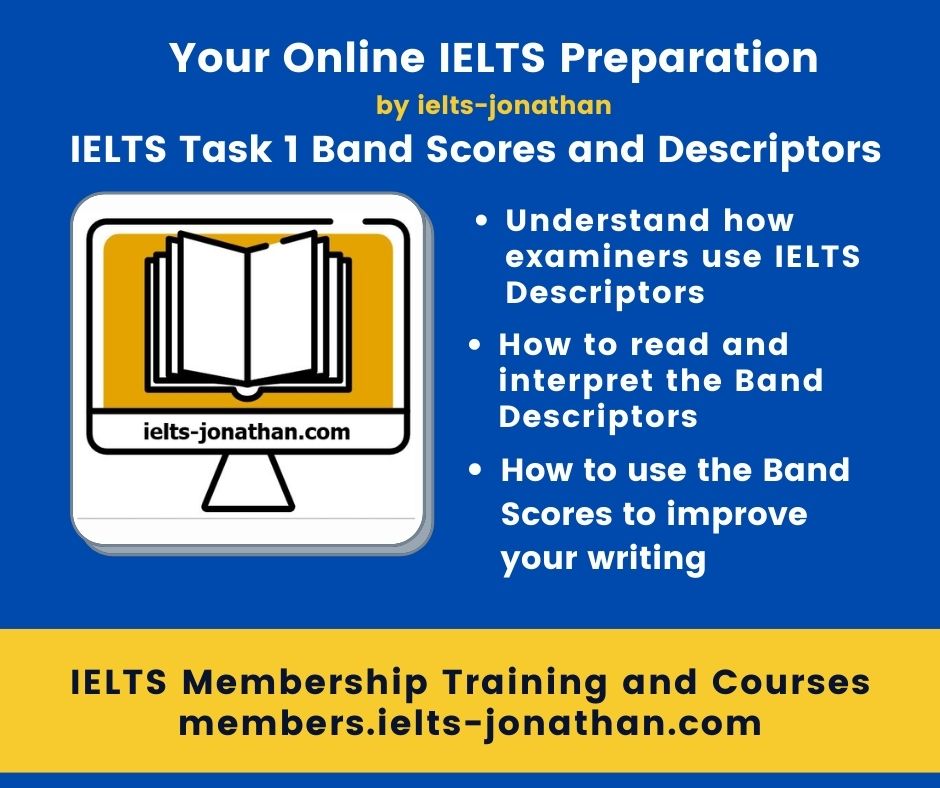Do you know why students often struggle to improve their IELTS Band Score
I often get students ask me how they can reach the band score they need. They also ask how to do this quickly, and with the least amount of effort or time.
This is one of my greatest ‘pet hate’ questions because when I hear or read this, it’s clear to me that the student does not really know what they need to do in the first place.
Another easy assumption is that they have been told already but haven’t acted or listened to the advice, or are still looking for the easy option that doesn’t exist. 🙁
This means that students are often going round in circles or chasing their own tails.
However, a great way to focus on improving you own writing score is to use the IELTS Band Scores, and grade what you are presently doing.
By being aware of what the IELTS examiners expect to see in your writing, and how they systematically award a band score, is one of the first steps to you improving your overall writing mark.
Why understanding the IELTS Band Descriptors is important
The IELTS Band scores are key to the IELTS test.
This information is useful to IELTS Schools and key to what IELTS teachers should teach.
So if they are useful to teachers, they have to be valuable to students as well, and for one good reason.
If you do not know what the assessment is based on, how can you aim to improve or even get closer to that score you need?
writing-band-descriptors-task-1Public Descriptors from IELTS.org
How to understand the IELTS band Scores
It is easy to understand how the band scores work in principal.
There are four columns that run vertically and each column has nine rows which correspond to a band score number.
In each of the rows there are ‘descriptors‘ which describe if something exists.
presents and adequately highlights key features/ bullet
points
or grades the existence of the statement.
presents and adequately highlights key features/ bullet
points but details may be irrelevant, inappropriate or
inaccurate
During assessment, a mark is applied to each of the four columns and the total grade is divided by 4 which can result in a full band score for example, Band Score 7, or a half band score like 7.5.
How to read a specialised document like the IELTS Band Scores or what the band scores really mean.
There are nine rows and each row describes language features at that level.
In the mid-level rows, between 5 and 7, there are certain sentences that signal a lot to examiners.
– TA at Band 5. ‘recounts detail mechanically with no clear overview‘ –
This means that even if you have a well rounded task, you cannot go higher than a Band 5 because the writing does not include ‘an overview’.
These are not gradable statements, they are statements of fact.
Once you find these, then you can work your way up to the gradable statements such as…
TA at Band 7. ‘presents a clear overview of main trends, differences or stages’
Another good example is…..
CC at Band 5. ‘presents information with some organisation but there may be a lack of progression‘
This example likely means that, although there are paragraphs, the sentences or the information is not arranged logically or does not flow or read smoothly.
What to do next.
First of all, look at you current language level if you have one.
This will indicate you ability to meet the lexical resource and grammatical range section of the band scores.
Then look at band score that you need to obtain and focus on the what you think the band level signifies.
Now you know the level, then you can work out what you need to do in order to achieve a score.
For example, notice that in order to get a band 8 in TA, you need to
‘present, highlight and illustrate key features/ bullet points clearly and appropriately’ – as well as provide an introduction and a sufficient overview
What do the descriptors really mean
So, lets just look a what some of the sentences mean in ‘layman terms’.
1 – Task Achievement
Task Achievement describes how well you have reported visual information in Academic Task 1 or responded to a prompt and written your reply in General Task 1.
This section can be divided into how skills and subskills.
In the Academic Task, you need an introduction, an overview and a report on all the key details.
In the General Task, you need a clear letter that presents the purpose of writing and which responds to all the bullet point prompts
At Band 6 this means;
- addresses the requirements of the task
(A) presents an overview with information appropriately selected - (GT) presents a purpose that is generally clear; there may inconsistencies in tone
presents and adequately highlights key features/ bullet points but details may be irrelevant, inappropriate or inaccurate
At Band 7 the means;
- covers the requirements of the task
(A) presents a clear overview of main trends, differences or stages - (GT) presents a clear purpose, with the tone consistent and appropriate
clearly presents and highlights key features/bullet points but could be more fully extended
What a BAND 7+ score looks like
In the Academic Task, make sure you have a clear introduction, an overview that reports the obvious trend, difference or notable stage and select the key features and report in logical paragraph or sentence order.
In the General Task, make sure you have a clear purpose in the introduction, maintain a suitable tone throughout and address all the bullet points in the prompts.
2 – Coherence and Cohesion
-At Band 6 this means;
- arranges information and ideas coherently and there is a clear overall progression
- uses cohesive devices effectively, but cohesion within and/or between sentences may be faulty or mechanical
- may not always use referencing clearly or appropriately
At Band 7 this means;
- logically organises information and ideas; there is clear overall progression throughout
- uses a range of cohesive devices appropriately although there may be some under-/over-use
What a BAND 7+ score looks like
In either the Academic or the General Task, make sure that paragraphs are used logically, and sentences (and information) within paragraphs are arranged to create an easy to read text. Make sure the reader is assisted by appropriate Linking and Referencing words, even if there might be some errors,
3 – Lexical Resource
At Band 6 this means:
- uses an adequate range of vocabulary for the task
- attempts to use less common vocabulary but with some inaccuracy
- makes some errors in spelling and/or word formation, but they do not impede communication
At Band 7 this means:
- uses a sufficient range of vocabulary to allow some flexibility and precision
- uses less common vocabulary but with some awareness of style and collocation
- may produce some errors in spelling and/or word formation, but they do not impede communication
What a BAND 7+ score looks like
In either the Academic or the General Task, try to display enough vocabulary which indicates your level and awareness of the English Language. There can be a few errors or mistakes as long as these do not alter the message you are communicating, so check the meaning, that it is appropriate and check the spelling.
4 – Grammatical Range and Accuracy
At Band 6 this means:
- uses a mix of simple and complex sentence forms
- makes some errors in grammar and punctuation but they rarely reduce communication
At Band 7 this means;
- uses a variety of complex structures produces frequent error free sentences
- has good control of grammar and punctuation but may make a few errors
What a BAND 7+ score looks like
In either the Academic or the General Task, try to display enough complex grammar structures that help the reader and are used accurately, and make sure you have checked your punctuation.
Conclusion and final points about using the IELTS Band Scores
Using the band scores is an excellent way to assess your own level and your current writing ability.
You can use the statement of facts in your preparation, so that these aspects become second nature in your writing, or at least part of a checklist. 🙂
With gradable statements, you may need the more objective/subjective opinion of a teacher or an IELTS Expert.
Gradable statements obviously you will mean you need to improve or work at focusing on these weaknesses, if you have any.
The good news is that by understanding the marking criteria already, you are already one step ahead in getting the IELTS score you need. 🙂
I’m Jonathan, an online-IELTS preparation specialist.
I help IELTS students achieve the IELTS score they need with courses, training, feedback and advice.
I have taught IELTS and University English in more than a dozen universities and schools around the world.
I’m a parent, traveller and passionate about language teaching and helping students achieve their dreams.
Whilst living in Austria or working in Asia, I run IELTS courses to help students get to where they want to be.
If you are serious about IELTS, connect with me to see how I can help you.




[…] How IELTS Task 1 is Evaluated […]